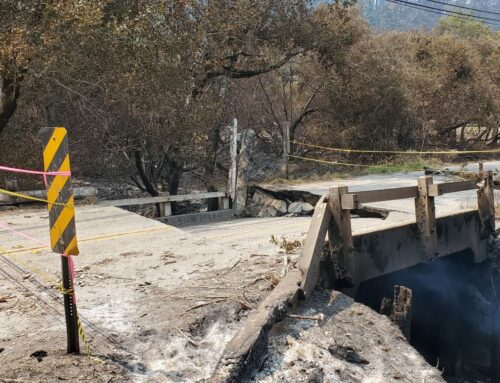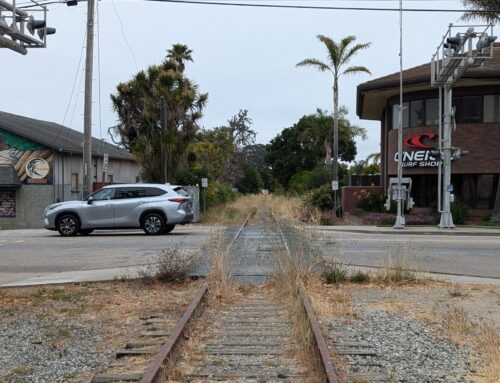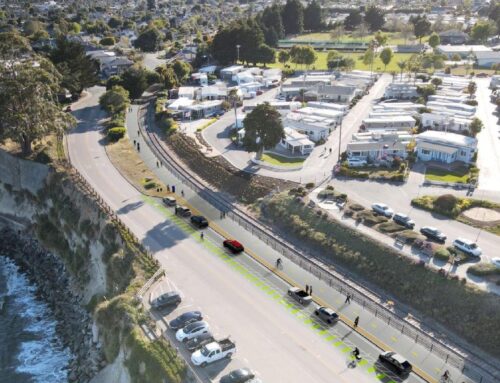Santa Cruz Local offers its news stories free as a public service.
We depend on people like you — we call them our Santa Cruz Local members — to chip in $9 a month or $99 a year to make sure vital information can be available to all. Can we count on your help?
SANTA CRUZ >> Ahead of an anticipated Feb. 4 vote on train or bus options on Santa Cruz County’s rail corridor, members of the county’s Regional Transportation Commission on Thursday gave their initial thoughts on which project to pursue.
Four commission members — Greg Caput, Lowell Hurst, Aurelio Gonzalez and Mike Rotkin — expressed their preference for a train option at Thursday’s meeting. Rotkin also wanted several questions answered and was not completely committed. Three commission members — Bruce McPherson, Manu Koenig and Jacques Bertrand — expressed preference against a train. The remaining five commissioners and alternates at the meeting were noncommittal: Donna Lind, Sandy Brown, Andy Schiffrin, Patrick Mulhearn and Randy Johnson.
Johnson, a Scotts Valley city council member, expressed concerns about costs and ridership projections of a train. “Every once in a while we have to pay attention to the taxpayer,” Randy Johnson said during the meeting.
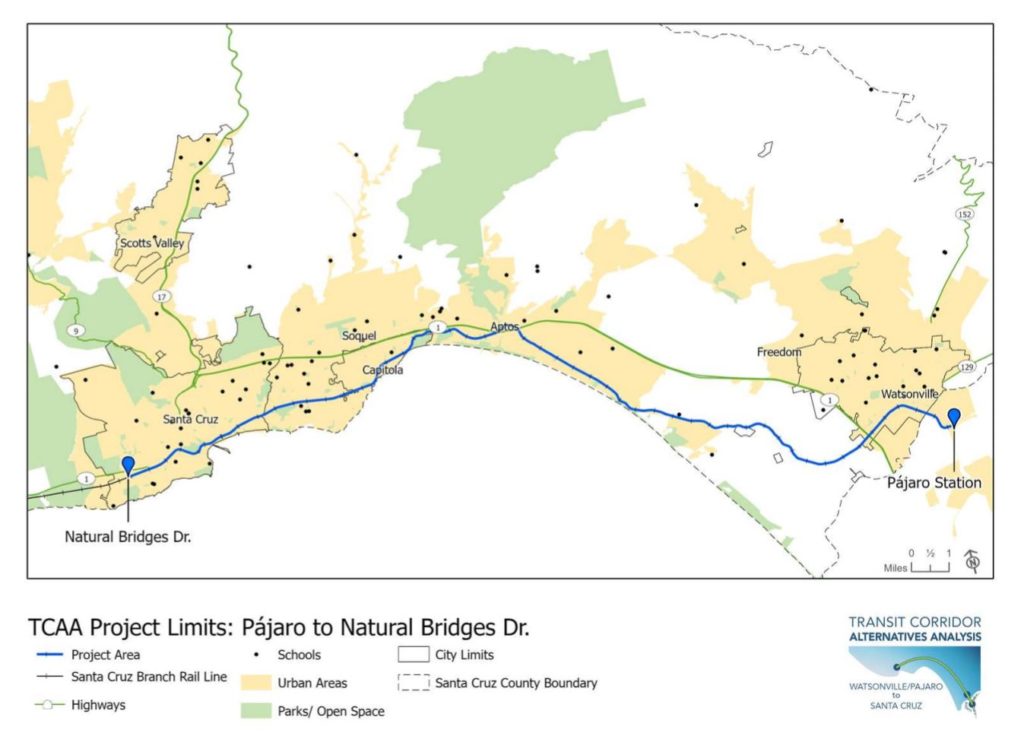
Others on the transportation commission who represent South County— especially Watsonville City Councilmembers Aurelio Gonzalez and Lowell Hurst and Santa Cruz County Supervisor Greg Caput — indicated that the decision is as much about social equity as money. Despite a shift to telecommuting because of the pandemic in recent months, many Watsonville residents’ jobs still require commutes.
“I know this is a hot item,” said Gonzalez, the transportation commission chairman. “We have to be equitable to everybody,” he said. “This is something that’s going to benefit the county and the country and this region not two years from now and not 30, but in the long run.”
At least three transportation commissioners — Rotkin, Lind and Koenig — said they wanted county voters to decide whether to pursue a passenger train of some kind on the rail corridor. Rotkin, a former Santa Cruz mayor, said the plan should consider 30 to 50 years into the future. Lind is a Scotts Valley city council member and Koenig is a newly elected county supervisor who represents areas of Live Oak, Soquel and Capitola.
Separately, the commission staff has stated that a new sales tax measure could appear on a future county ballot to help pay for train or bus options, according to a Transit Corridor Alternatives Analysis released by transportation commission staff this month. Train supporters said the Biden Administration could help fund the project, but nothing is certain.
More than 190 people attended Thursday morning’s online-only meeting at its peak. About 20 residents spoke in favor of the train option and 10 spoke against it or wanted more information.
Rail versus bus
Condensing a 330-page report released this month, regional transportation staff on Thursday discussed advantages and disadvantages of alternatives of a commuter train, a light rail train and a bus rapid transit system next to a proposed trail on the rail corridor. The commission already has decided to pursue a trail next to either a train or bus line — rather than trail only.
The train options run from Pajaro to Natural Bridges State Beach on Santa Cruz’s Westside. The bus option would run from Pajaro to Aptos then use local roads and the highway as it continues toward Santa Cruz, said Stephen Decker, a consultant who is assisting transportation commission staff.
The Regional Transportation Commission staff proposal calls for commuter rail or light rail. Commuter rail is faster and allows for more passengers but has longer distances between stations. Light rail would be quieter, slower and has more ridership potential than a commuter train, transportation commission staff wrote.
Here are some other highlights as outlined by transportation commission staff:
Bus rapid transit
- Uses about 7 miles of 15 mile corridor. It would run from Pajaro to Highway 1 in Aptos, then local roads to Capitola and take about 90 minutes from Pajaro to Natural Bridges.
- Runs every 15 minutes 5 a.m. to midnight
- 23 stations or platforms
- Less capacity for bikes and more awkward loading than train or light rail
- Can more easily adapt to sea-level rise and erosion along coastal corridor areas
- Electric bus noise is lower than train or light rail noise
- Projected to have 37,500 countywide riders in the year 2040 compared with about 34,000 projected train or light rail riders.
- Estimated $410 million to build. It costs less than commuter train or light rail but there are fewer potential funding sources.
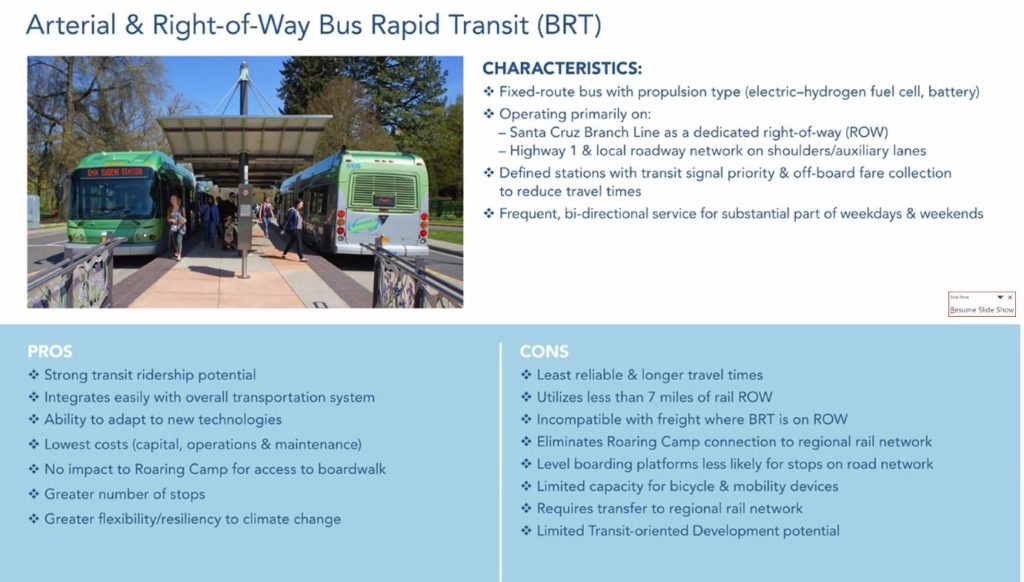
Commuter rail
- Uses more of rail corridor, 40 minutes from Pajaro to Natural Bridges
- Runs every 30 minutes 6 a.m. to 9 p.m. during peak weekday hours
- 11 stations or stops
- More capacity for bikes
- Electric commuter rail is noisier than light rail or buses
- Easier to connect with regional rail systems than light rail
- Coastal track, trestles require upkeep for sea-level rise and erosion
- Freight trains possible
- Estimated $478 million to build. It costs more than other options but more state, federal funding potential.
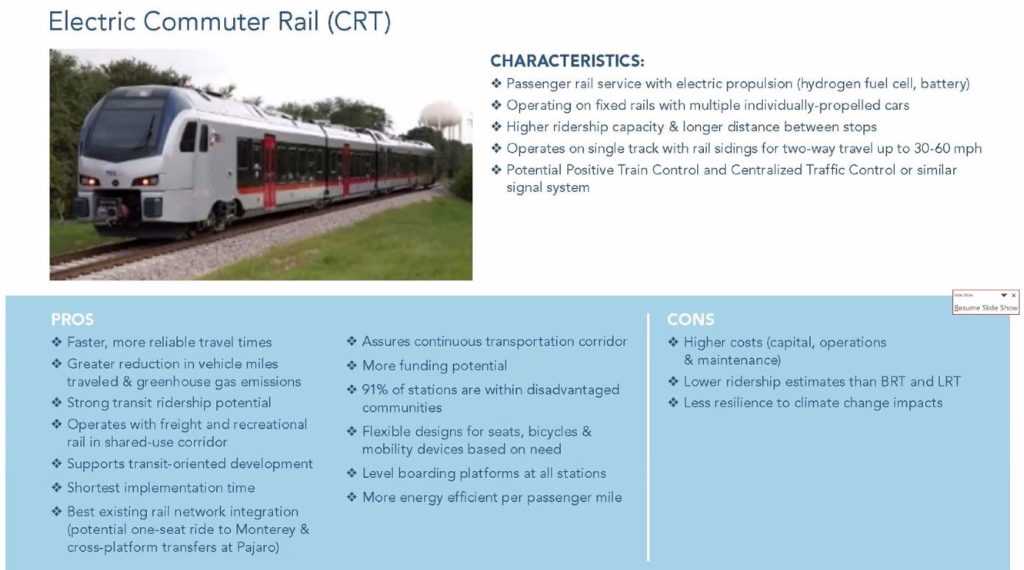
Light rail
- Uses more of rail corridor, roughly 55 minutes from Pajaro to Natural Bridges
- Runs every 30 minutes 6 a.m. to 9 p.m. weekdays. “Less reliable” punctuality than commuter train
- 15 stations or stops with the more stops near disadvantaged communities than other options
- Level boarding with street for easy access for bikes, wheelchairs and other mobility devices
- Electric light rail is quieter than commuter rail, noisier than buses
- Projected slightly lower ridership than commuter train
- More complicated to connect with regional rail systems
- Estimated $465 million to build. It costs more than bus rapid transit system, less than commuter train.
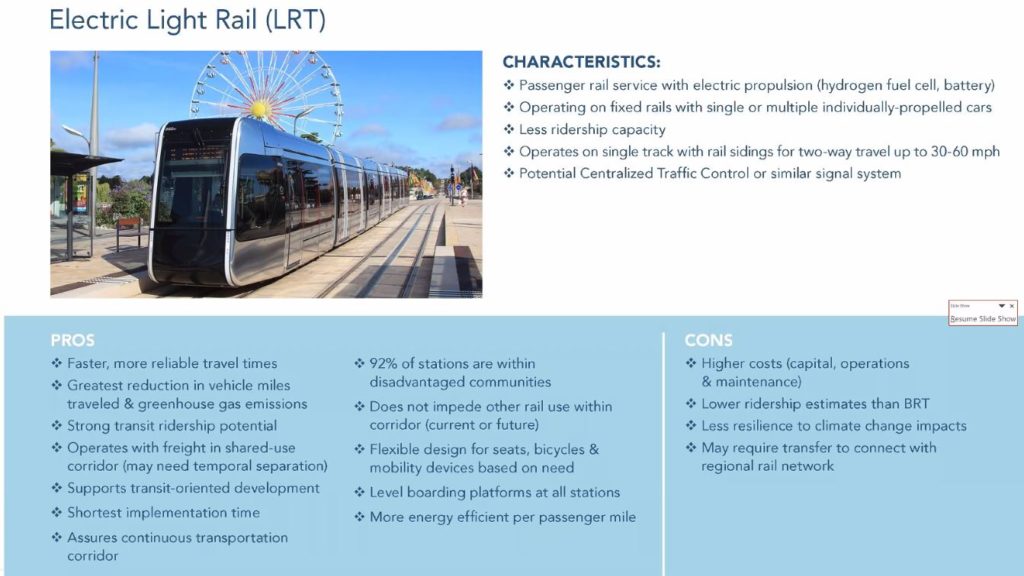
The staff also briefly discussed an autonomous road train system, but its expected cost to build of more than $700 million and other factors made it less attractive than other options for staff and commissioners.
The transportation commission’s staff analysis lists funding sources and assumptions. The transportation commission’s executive director said last year that cost estimates will remain murky until a full environmental impact report is complete. A business plan is expected to be drafted by regional transportation commission staff this year.
The staff has said it works toward a triple bottom line of social equity, economic and environmental improvement.
Some Santa Cruz Local readers asked for how the rail would affect residents’ lives. Regional Transportation staff wrote in their alternatives analysis that some of these intended benefits informed their preference for light rail and commuter train options:
- Connecting Watsonville and Santa Cruz is intended to expand access to jobs, education and housing.
- Building transit near homes can reduce traffic, promote healthier lifestyles and create more sustainable communities.
- Increased access to car-free travel statewide with potential rail connections in Monterey County and the San Francisco Bay Area.
- Transit on a dedicated line will increase transit ridership, expand travel choices, create more paths to jobs and schools and improve quality of life.
- Reduce car trips, although the number of trips is disputed
- Improve mass transit travel time and reliability
- Improve safety because trains are generally safer than driving for passengers and pedestrians
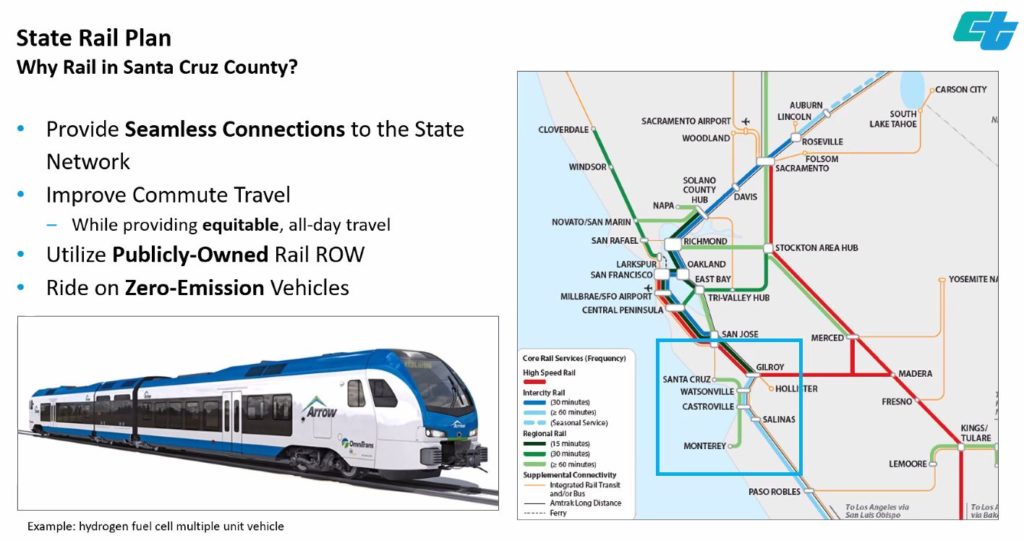
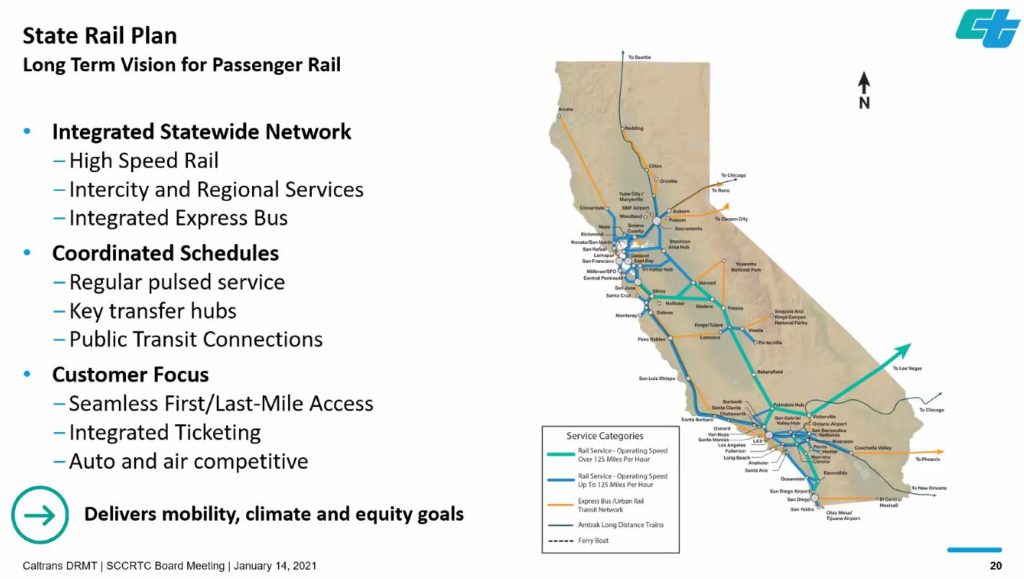
Several people called in to the meeting to express their support or opposition to a train project.
Nancy Faulstich, executive director of Regeneración Pájaro Valley Climate Action, said the community is “segregated and disconnected” and advocated for a train. She asked, “ How many of you have ridden a bike to a bus stop not knowing if there will be room for your bike on the bus?”
Another woman who identified herself as a Watsonville High School graduate said, “Everyone I grew up with in South County” supports the train proposal. She added, “It’s about investing in the community. It will benefit the entire community … We live in one of the richest counties in one of the richest states in the richest country in the world. It’s outrageous to think that anybody would say we can’t afford public transportation.”
Bud Colligan, a leader of the trail-only advocacy group Santa Cruz County Greenway, said the commission staff should, “stop wasting our precious tax dollars and start developing a realistic and doable way to use the corridor.” Colligan added, “A train is not feasible or fundable in a county with 270,000 people, most of whom have no possibility of ever using it.”
Others also had opinions at Thursday’s meeting
Bruce Mcpherson, regional transportation commissioner and county supervisor: “It’s a good public policy to preserve the option to build passenger rail. Understanding that this is a possible future use, but really one that we can’t afford now. I do think we need to focus on fiscal responsibility and fulfilling our Measure D project promises that we gave to the voters in November of 2016 … I don’t believe another ballot measure to build rail service is fiscally responsible, nor is it politically realistic at this time. But I fully support maintaining the freight service to Watsonville because it is vital to the city’s economy … We need to put this debate to rest and move forward on projects that are financially feasible.”
Manu Koenig, regional transportation commissioner and county supervisor: “One of the most pro-train voices on this commission (former Santa Cruz County Supervisor John Leopold) is no longer here because the voters spoke and put me in the seat instead … We have 60% of the funds needed for the capital costs, and only about 45% of the operating costs. Best case scenario, it’s assuming we get all the funding sources we outline, which is not going to happen either … We need to stop any more spending on rail whatsoever.
Micah Posner, former Santa Cruz City councilmember, chairman of Santa Cruz chapter of the Sierra Club: “Socialized transportation, like socialized medicine, is expensive for the government. But it’s a bargain for society as a whole, especially people that have a hard time affording cars — which are the kind of people we should be serving.”
Robert Singleton, executive director of the Santa Cruz County Business Council: “In 2017, after hearing from members of the RTC for and Greenway and multiple ridership studies, 86% of our membership voted for a trail-only option. Because they found that the train options were financially infeasible for providing the level of service and value to reduce traffic during peak times on Highway 1 … We don’t know why the RTC didn’t do an actual opinion poll since a tax measure is no doubt going to be needed … We feel it’s really important to put this issue to a countywide vote.”
Rod Diridon, Sr., chair emeritus of the U.S. High Speed Rail Association: Remember that you’re building a project for the next 100 years. You’re not building it for 30 years from now, you’re building it for 100 years from now. And if you lose that asset as a corridor, then you lose it forever. And your valley, your area is going to require that transportation over the longer term. So please have the long vision … And by the way, huge amounts of funding are being created now by the Biden administration, in the carbon disincentive fees, over a trillion dollars. And it’s going to go to projects that are shovel ready, because they’re also creating jobs. So if you’re ready, you’re going to receive funding, don’t worry about that. It’s a matter of being ready.”
Andy Schiffrin, Santa Cruz city planning commissioner, regional transportation commission alternate for Ryan Coonerty: I’m always amazed that people who think they know the future, because it keeps surprising me. I don’t know what the Biden administration is going to do … It is critical that we don’t give up the possibility of having, you know, a different transportation mode along a corridor that we own … The idea that somehow a trail is going to provide a meaningful option for people in the South County or people in the North County, going in the opposite direction for commuting for those kinds of trips, it just doesn’t appear realistic to me.”
Keith Otto, county resident: “Consider the huge cost, hundreds of millions of dollars to build, tens of millions of dollars each year to maintain, that maintenance being a forever liability. Yes, infrastructure projects are expensive — all the more they need to be effective, and passenger rail will not be effective for Santa Cruz County. The (Transit Corridor Alternatives Analysis) projected ridership numbers are low. It does not move large numbers of people to where they need to be. Rail isn’t flexible and transit times are long. A better solution is to invest in Santa Cruz Metro. Restore the service cuts that were made back in 2016.”
The public can provide written input on the commission’s decision by noon Feb. 3. Email [email protected].
How we got here
- October 2012: The Regional Transportation Commission purchased the rail line from Union Pacific for $14.2 million. About $11 million came from the state to support development of passenger rail service. If a transit option is selected that doesn’t use the rail, those funds must be returned to the state.
- January 2019: The 12 voting members of the transportation commission unanimously approved a high-capacity public transit option to accompany a multi-use trail within the rail corridor. Prior options had included a “trail-only” plan, a rail-and-trail plan, or a trail with bus service.
- June 2020: Approval of public transit kicked off another study: the Transit Corridor Alternatives Analysis that started in January 2020. It narrowed 25 potential transit options to four alternatives that were approved in June: bus, electric commuter train, electric light rail, and an autonomous train on wheels. The selection of the four options was informed by two earlier public open houses and a survey.
- October 2020: The upcoming open house is the third major milestone of the Transit Corridor Alternatives Analysis. It’s the first time that more detailed information about cost will be available for the four options. Based on staff analysis, a staff-preferred option will be presented for public comment.
- January 2021: After commissioners review public input gathered at the October open house, commissioners will vote on whether to approve the staff recommendation.
Editor’s note: Bud Colligan has been a Defender-level member of Santa Cruz Local since 2019. As a policy, stories that reference or quote a Santa Cruz Local donor who has contributed $1,000 or more include a written disclosure.
Read the Transit Corridors Alternatives Analysis.
Related stories
📰 Santa Cruz County rail transit options to be narrowed Sept. 7, 2020
Stephen Baxter is a co-founder and editor of Santa Cruz Local. He covers Santa Cruz County government.



